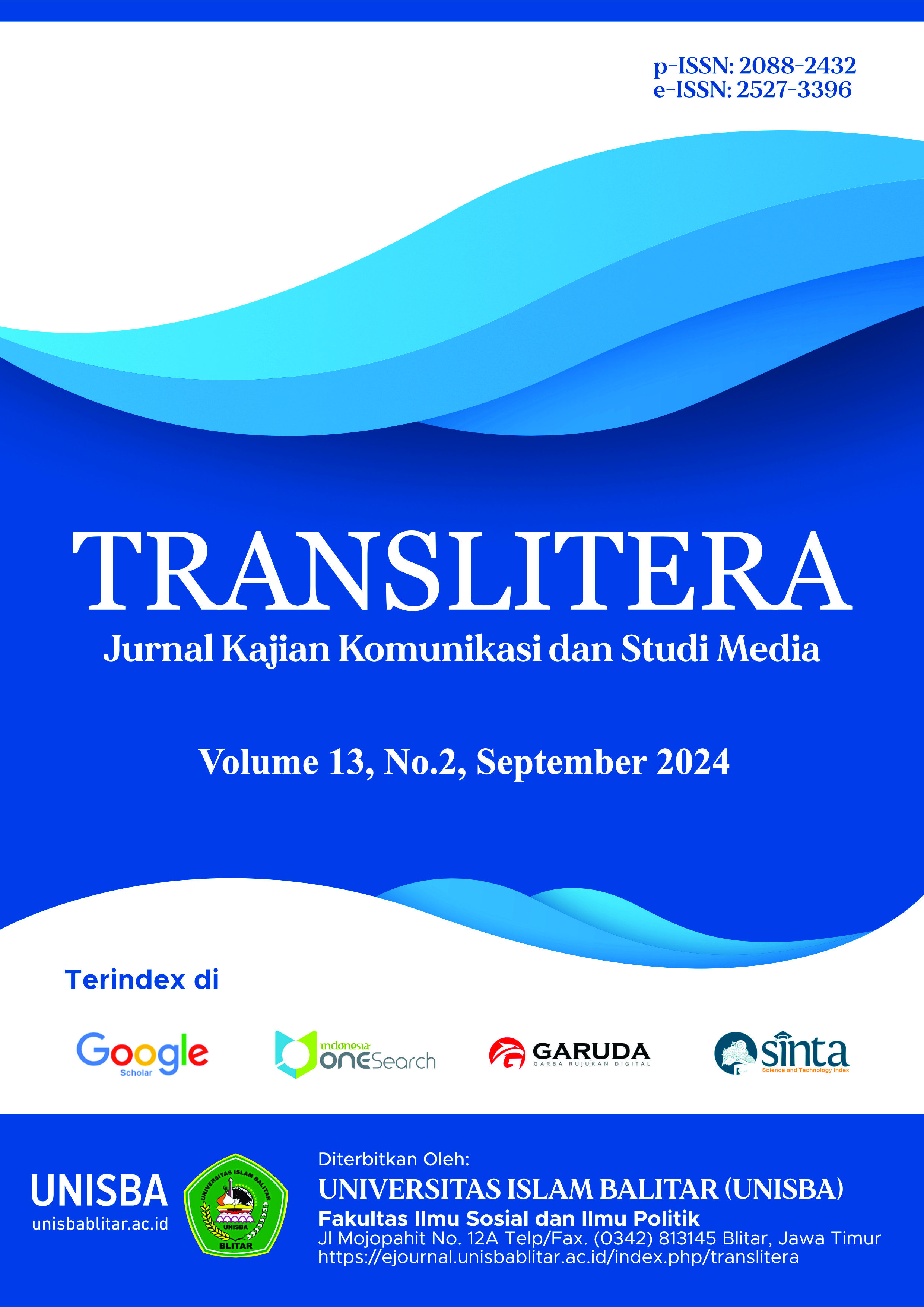the Semiotic Analysis of Javanese Language Usage in Main News of Jawa Pos Radar Blitar Newspaper, January-February 2024 Edition
DOI:
https://doi.org/10.35457/translitera.v13i2.3892Keywords:
Semiotika, Berita Utama, Koran, Bahasa JawaAbstract
Javanese is a regional language commonly used by the Javanese people for interactions. The minimal use of Javanese Krama, this language is still in use today. The media company Jawa Pos Radar Blitar combines Indonesian and Javanese languages to disseminate information. This study aims to examine the use of Javanese in the main news articles of Jawa Pos Radar Blitar, focusing on the types and meanings. Researchers use qualitative research method to uncover data facts. The analysis results of using Semiotic Roland Barthes theory indicate there are three types of Javanese language in the January-February 2024 edition, namely ngoko, madya, and krama. Javanese Krama is not in Jawa Pos Radar Blitar. Ngoko is the most frequently used, with 13 words have positive meanings, while madya has only 3 words with negative. Positive meanings are defined as clear and singular, whilenegative meanings are ambiguous and have multiple interpretations.
References
Ariyanti, J. (2016). Bentuk Makna Simbolis dan Fungsi Tradisi Nyadran di Desa Kedunglo, Kecamatan Kemiri, Kabupaten Purworejo. Jurnal Program Studi Pendidikan Bahasa Dan Sastra Jawa, 08 (03), 67–77. http://ejournal.umpwr.ac.id/index.php/aditya/article/viewFile/3040/2877
Arlini, E. W., & Saddhono, K. (2024). Kekerabatan Bahasa Ogan Dan Bahasa Jawa: Kajian Linguistik Historis Komparatif. Jurnal Metamorfosa, 12(1), 30–44. https://doi.org/10.46244/metamorfosa.v12i1.2424
Basri, S., & Sari, E. (2019). Tari Remo (Ngremong): Sebuah Analisis Teori Semiotika Roland Barthes Tentang Makna Denotasi Dan Konotasi Dalam Tari Remo (Ngremong). GETER : Jurnal Seni Drama, Tari Dan Musik, 2(1), 55–69. https://doi.org/10.26740/geter.v2n1.p55-69
Gordon, J., Natadjaja, L., & Febriani, R. (2020). Kajian Visual Video Musik BTS Menggunakan Teori Semiotika. Jurnal DKI Adiwarna, 1(16), 13.
https://publication.petra.ac.id/index.php/dkv/article/view/10180
Josaphat, Y. A. P., Cahyaningrum, A. N., Ladifa, H., Syach, S. F. N., & Khana, S. W. C. (2022). Eksistensi Bahasa Jawa Bagi Masyarakat Jawa Di Era Westernisasi Bahasa. Titian: Jurnal Ilmu Humaniora, 6(1), 65–71. https://doi.org/10.22437/titian.v6i1.16046
Kusumawijayanti, A.R., Harliantara, Rendi, P. (2020). Siaran Layanan Publik Radio Mayangkara FM Kota Blitar. Komunitas: Jurnal Pengembangan Masyarakat Islam. 11(1), 59-78.
Liando, M. R. (2021). Religiusitas Dan Dimensi Ekologis Di Balik Mitos Burung Manguni Pada Masyarakat Minahasa. Jurnal JINNSA (Jurnal Interdipliner Sosiologi Agama), 1(2), 117–133. https://doi.org/10.30984/jinnsa.v1i2.129
Nur Afifah. (2021). Analisis Makna Semantik Bahasa Jawa Terhadap Bahasa Indonesia Di Desa Hapesong Baru. LINGUISTIK : Jurnal Bahasa & Sastra, 6(1), 66–77.
Nurindahsari, larasati. (2019). Analisis Semiotika Makna Motivasi Pada Lirik Lagu “Zona Nyaman” Karya Fourtwnty. Medium, 6(1), 14–16.
Witya Fitriah, Muhammad Rapi Tang, & Anshari. (2023). Repesentasi Semiotika Novel Merindu Baginda Nabi Karya Habiburrahman Elshirazy sebagai Bahan Ajar Pembelajaran Bahasa Indonesia di SMA (Kajian Semiotika Roland Barthes). Jurnal Onoma: Pendidikan, Bahasa, Dan Sastra, 9(1), 407–421. https://doi.org/10.30605/onoma.v9i1.2459
Yelly, P. (2019). Analisis Makhluk Superior (Naga) Dalam Legenda Danau Kembar (Kajian Semiotika Roland Barthes; Dua Pertandaan Jadi Mitos). Jurnal Serunai Bahasa Indonesia, 16(2), 121–125. https://doi.org/10.37755/jsbi.v16i2.20
Downloads
Published
Issue
Section
License
Authors who publish with this journal agree to the following terms:
- Copyright on any article is retained by the author(s).
- Author grant the journal, right of first publication with the work simultaneously licensed under a Creative Commons Attribution License that allows others to share the work with an acknowledgement of the work’s authorship and initial publication in this journal.
- Authors are able to enter into separate, additional contractual arrangements for the non-exclusive distribution of the journal’s published version of the work (e.g., post it to an institutional repository or publish it in a book), with an acknowledgement of its initial publication in this journal.
- Authors are permitted and encouraged to post their work online (e.g., in institutional repositories or on their website) prior to and during the submission process, as it can lead to productive exchanges, as well as earlier and greater citation of published work.
- The article and any associated published material is distributed under the Creative Commons Attribution-ShareAlike 4.0 International License












